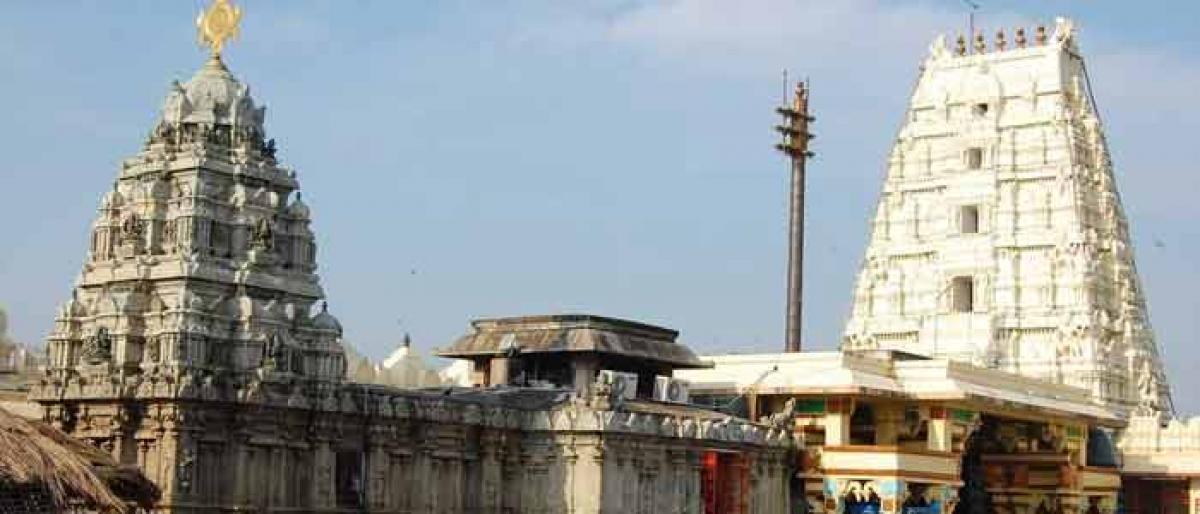Live
- A Guide to Temperature and Humidity Standards in Data Center Server Rooms
- Gadwal collector briefs on details of voters
- Jupally Krishna Rao takes part in Alampur rallu
- Bharath Prasad files 3rd Nomination
- Baisakh Month: A Time of Auspicious Beginnings and Sacred Festivals
- Oust BJD govt for overall development, says Shah
- Unveiling the Hidden Gems: Surprising Health Benefits of Garlic Peels
- Overcoming Sleep Struggles: A Comprehensive Guide to a Restful Night
- RTC bus hit the auto
- MLA Kuchukula Rajesh Reddy participated in the Birappa festival
Just In

Legends surround Srikalahasti, the temple town near Tirupati. Home to the ancient Shiva Temple, the Srikalahasteeswara Temple, this town has been the centre of many legends, stories and folklore.
Legends surround Srikalahasti, the temple town near Tirupati. Home to the ancient Shiva Temple, the Srikalahasteeswara Temple, this town has been the centre of many legends, stories and folklore. Here is where Lord Shiva’s famous devotee Bhakta Kannapppa offered his own eyes to staunch the bleeding from the Shiva Lingam’s eyes.
Here is where the oil lamp that flickers as if by the touch of wind, glows steadily in the airless sanctum sanctorum of the Vayu Linga. Here is also where, Lord Shiva’s devotees Sri, Kala and Hasti - the spider, the serpent and the elephant - attained salvation, merging into the Vayu Lingam in the temple. Today the idol of Sri kalahasteeswara stands with a spider at the bottom, a five hooded snake crowning the top and elephant tusks adorn it on either side. So, it isn’t just the presiding deity who draws his name from a legend, but the town itself.
The Kalahasteeswara Temple stands on the banks of the river Swarnamukhi under the shadow of a hill. And is one of the temples dedicated to the Panchabhoota (the five elements) Lingams of Shiva. While it is the Vayu Lingam representing wind that is here, the other lingams representing fire, water, sky and earth are manifest at Arunachalam, Thiruvanaikaval, Chidambaram and Kanchi.
This ancient temple was originally built in the 5th century by the Pallavas, which was later extended by the Cholas in the 11th and 12th centuries. But it was in the 16th century, under Krishnadeva Raya that it was most celebrated. And since then, it hasn’t been just a mythical place of worship but the fountainhead for art and culture.
Vilasini Natyam, which is the traditional temple dance form originated here and what started out back then in the 13th and 14th centuries as a backdrop for the deities in the temple is what has today evolved to become one of the most appreciated fabric for its artistic value. That there is the story of Kalamkari.
Kalamkari, literally meaning craftsmanship of the pen, refers to the hand painted or block printed cotton fabric produced in the towns of Sri Kalahasti and Machilipatnam in Andhra Pradesh. Before the actual process of art begins, the cotton fabric has to be prepped for drawing by washing it in water and soaking it in milk. A master artist then draws the design freehand in bold black strokes using a charcoal pencil.
The cloth is then soaked once again, this time in boiling water before colours are filled in by the artisans using a bamboo kalam (pen). The colours are always natural and made from ingredients like indigo and myrobalan fruit. From sarees and dupattas to bed linen, this hand-painted cotton textile is considered hip not just in the art circles and there is a huge demand for it today.

© 2024 Hyderabad Media House Limited/The Hans India. All rights reserved. Powered by hocalwire.com







